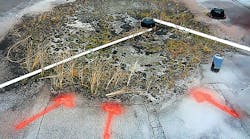How much does your warranty cover? If you’re not familiar with the fine print, you’re likely to answer incorrectly thanks to common misconceptions about what warranties do and don’t cover.
Don’t get caught off guard. Do the right thing for your roof by reviewing your warranty, fully understanding its terms and implementing a smart maintenance plan that will ensure you stay compliant with your roof’s warranty for its entire lifespan.
How Warranties Work
People often think of a roof warranty in the same way they think of warranties on electronics, but nothing could be further from the truth. Roofs typically come with a two- to five-year warranty from the contractor that covers defects in the installation process, but beyond that, your warranty coverage is coming entirely from the manufacturer’s material warranty, and that only covers the materials that make up the roof.
Building owners tend to think of warranties as insurance policies, but they’re not. Likewise, they’re not a maintenance agreement or a guarantee that the roof will be watertight or constructed with quality workmanship. Outside of the contractor’s warranty period, it’s only the materials that are covered. If the material naturally starts to come apart from dry rot or other natural elements, that would be covered, but those instances are rare. Roofing materials typically last as long as the warranty says they will.
Despite that, it’s important to maintain your warranty even though the odds are that you’ll never need to use it. If your roof turns out to have a material defect, it can cost as much to fix as the original cost of your roof. Maintaining your warranty protects your wallet, not just your building.
Typical Exclusions
Most exclusions are things you would assume are covered by a roof warranty, such as damage to the interior caused by a roof leak. Warranties typically exclude these events from coverage.
- Interior damage
- Damage to other parts of the roof
- Loss of production
- Loss of inventory
- Equipment damage
- Acts of God and war
- Vandalism
- Environmental damage
- Blisters
- Wind
- Ponded water
How Much is Covered
Warranty specifics vary depending on a number of factors. It’s important to pay attention to the verbiage of your warranties, even with simple things like leaks. If a leak is determined to be the fault of the installer, then the manufacturer’s warranty won’t cover it. It also depends on how long it takes for you to notice the leak because by the time you notice something is wrong, you could be outside of the contractor’s warranty period.
Pay special attention to the warranty exclusions as well. Most of them are items you might expect a warranty would cover. (See “Typical Exclusions” on page 20.) All warranties are different, so read your exclusions carefully and have a lawyer look them over too. Remember that it may not always be a storm that damages your roof – you could have an air conditioning unit with a loose door that comes unhinged and punctures your membrane. Most warranties exclude punctures, so if equipment is what damages your roof, there goes your warranty. If you need to clarify any of the language, obtain an explanation in writing to keep with the rest of your warranty records.
Other considerations to watch for include:
Transfer of ownership. If you sell the building, the roof warranty may be void if it doesn’t specifically stipulate that the warranty moves to the new owner.
How legal disputes are settled. You would think that if there are any legal disputes, you would handle them in the state where the roof is. That’s not always true. Some warranties require disputes to be handled in the state where the manufacturer is, so if they’re based in Pennsylvania, they may have it in their clause that you must settle legal disputes in Pennsylvania and not where the actual building is.
Is it a pro-rated warranty? All pro-rated warranties have a cost involved. The longer the term of the warranty, the higher the cost rises. A no dollar limit warranty offers the least liability for future costs during the warranty term, but you have to know what is covered.
If you live in an area with special weather considerations, you may decide to customize your warranty with additional coverage. For example, if your location is prone to hurricanes or tornados, you may want to opt for a wind speed warranty that will cover damage from winds up to a certain speed. Roofs in regions with hail could benefit from a warranty that includes puncture resistance; some policies cover damage from hailstones up to 2 inches in diameter.
Know Your Roof Maintenance Options
Are your roof maintenance protocols reactive or proactive? Put together a smart roof management program so you’re not putting off needed repairs until a leak shows up inside.
Roof Maintenance Program
- Annual inspections by roofer, maintenance staff or
building engineer - Preventive maintenance performed by people who aren’t necessarily trained for roof warranty compliance
- Minimizes unexpected problems and costly repairs
- Extends the useful life of the roof
- Tracks repair history, but other records are inconsistent or limited; may not have the documentation necessary to file a warranty claim or insurance mitigation
- Some documentation is better than none
Roof Asset Management Program
- Annual inspections by a qualified third party
- Preventive maintenance performed by qualified, trained people who understand warranty compliance
- Minimizes unexpected problems and costly repairs
- Extends the useful life of the roof
- Tracks repair history, warranty information and
maintenance records consistently and comprehensively - Contains financial projects, anticipates costs based on roof life expectancy, establishes budgets for replacement costs, and maintains documents needed for warranty compliance and insurance
How to Lose Your Warranty Claim
The easiest way to void your warranty is to put off maintaining it. Regular maintenance by an approved contractor is crucial if you want to keep your warranty valid. Most warranties will have an exclusion that says if the roof isn’t properly maintained, the manufacturer will void the warranty. Make sure the roof drains are clear of debris and the gutters are functioning properly. When you have a buildup of debris, vegetation can start to grow and cause all kinds of problems. A buildup of water around a clogged drain can lead to a collapse of the roof itself.
Most warranties require an inspection and basic maintenance once a year. Survey the roof regularly to pinpoint smaller problems before they grow into bigger ones. Evidence of roof damage won’t show up inside the building until it’s advanced, and by then neglecting your roof has likely voided your warranty. Institute a schedule for roof maintenance to stay on track with required inspections and repairs.
Along with your inspection and maintenance schedule, make sure you keep track of anyone who accesses roof. Sometimes people can leave equipment or tools laying around and they can damage the function of the roof or the membrane, so it’s important to keep records of anyone who was on the roof, how long they were there and what company they were there with. If you don’t, that can trigger one of your exclusions and cause other problems.
As you near the end of your warranty period, you may have the opportunity to extend it for additional years, often after the manufacturer conducts its own inspection. A well-maintained roof will have the option of renewing the warranty beyond the original terms. Think about getting the most out of your roof system.
Eric Smause is the Founder, President and Senior Roof Consultant for Atlantic & Caribbean Roof Consulting (ACRC). Paul Smause is a Project Manager for ACRC.


